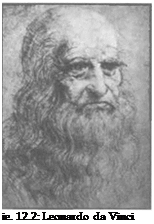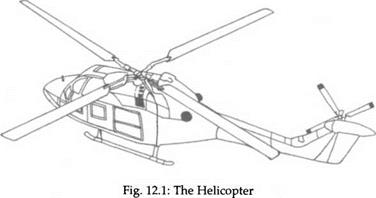HELICOPTERS
Aircraft needs to pick up immense speed, on the ground, before it can get airborne. The speed at which air runs over and under the wings (Bernoulli’s principle), provides the upward thrust. Higher speeds generate more powerful thrusts and thence more lift.
Aircraft have giant wheels. The runways at modern airports are very long. The pilot starts the engine, revs it up and waits for the engine to gain enough power and thrust before he pulls the lever. The aircraft gains speed. More speed and still more speed! Then, suddenly, the nose of the aircraft tilts up. It cuts its way through space. The nose moves further up. The aircraft gets bodily lifted. The steep climb ends, once the aircraft gains the height it needs to cruise. The pilot presses a control button. The wheels retract and slip snugly into the body of the aircraft.
Runways are essential to put an aircraft in flight and permit it to land back. The aircraft is of no use where this facility does not exist. At such places, the helicopter comes into play (Fig. 12.1). The helicopter has a main rotor and a tail rotor. They are mounted on top of the frame. The main rotor provides the lift. The tail rotor checks the tendency of the helicopter to pull in a direction opposite to that set by the main rotor. The rotors rotate at very high speed, force the air to part and provide the necessary lift.
The helicopter can move in any direction or simply hover over one place by suitable adjustment of the angles
of the blades of the main rotor and the tail rotor. The adjustments are made with the help of pedals and levers.

 |
The basic idea for the helicopter goes back to 12th century China. A toy-maker shaped a slim elegant shaft with holes from wood. Into the holes, he inserted and fixed small arms, shaped with care. The toy looked like a huge screw. The man added three propeller-like wings attached to one end. A firm tug at the free end of a string that wound round the central rod sent the toy into a spin. This spin produced the lift and made the toy fly.
Leonardo da Vinci, one of the greatest artists of all times, was a genius (Fig. 12.2). His interests were varied. He loved to paint. Da Vinci spent hours, observing birds in flight. He drew pictures of birds in flight, studied the anatomy of birds to find out the secret of flight. This quest led him to the details about the old Chinese toy.
He worked on the design and
drew the blueprint for a machine that resembled a giant screw. He called it, ‘Helipteron’, by combining two Greek words, Heli (means spiral) and Pteron (wings). Da Vinci believed that it could fly. But how could it draw power to stay airborne? He thought four men could work the bars, attached to the airscrew. He left it at that.
Centuries later, Lomonosov, a Russian scientist, put a crude form of the helipteron in flight in 1754. In 1843, Sir George Cayley spent time to fabricate a flying machine that would take off vertically.
Louis and Jaques Breguet were siblings. They flew kites, spun out boomerangs that returned to them after short flights. Then they read about the helipteron. They assembled crude replicas with whatever they could lay their hands on. This childhood interest led them into the field of flight, once they were on their own. Charles Richet, another young man, joined them. The three spent all their spare time on the design of the helicopter. They called it the Gyroplane. The rotors whirled very fast. In 1907, the machine rose by 0.6 m on the first attempt. On the second try, it lifted itself bodily to a height of 1.6 m.
In the same year, Paul Cornu came up with a more effective design. It had twin rotor blades, powered by a gasoline engine. The helicopter lifted itself and Paul up in space. It rose to a height of 0.6 m and stayed aloft for about 20 seconds. In the next trial, the helicopter rose up, taking Paul and his brother too aloft.
These were small beginnings, faltering steps taken by the pioneers. It took three more decades before the helicopter truly entered the field of aviation. Heinrich Focke, a German technologist, studied the work done by the pioneers. He improved on the designs. He carried out tests with his machines. Finally he felt confident that he had a design of a helicopter that would fly as freely as an aircraft.
In 1938, Heinrich announced that he would hold a public demonstration in Berlin. Huge crowds gathered to watch the air show. The helicopter stood at the centre of a wide open ground. Hanna Reitsch, a daring young dame, was at the controls. Heinrich went round, making last minute checks. Finally, sure that everything was in perfect working order, he signalled to Hanna. She started the engine. The deafening sound of the rotors, whirling madly, resounded in the air. People craned their necks to get a better glimpse of the grand show. The helicopter rose in space. It was incredible. The machine kept gaining height. On and on to record a height of 2,400 m! It flew forward at 120 kmph; and backward at the speed of 32 kmph. It covered a distance of about 225 km. The helicopter came of age, on that historic day.
From then on, its growth was phenomenal. It developed more range and speed, and found its place in civil and military operations.
Helicopters airlift wounded soldiers from forward lines to base hospitals; fly in to drop men and material in difficult terrain, that are not accessible by road; maintain the supply line to forward posts. Helicopters are found active in war zones and disaster stricken areas. They carry out survey operations and weather studies. On ceremonial occasions, like the Republic Day, they fly low along or around the venue, drop flowers that make the scene truly colourful.
Helicopters were held in readiness, on 24 July 1969, to pick up the astronauts when Apollo 11 Command Module touched down on the high seas. The helicopter hovered above the space capsule. It dropped a flotation ring to the capsule and pulled up the’ astronauts.
In India, helicopters fly supply missions to several forward posts in the Himalayas. These missions are dangerous. Pilots steer the helicopters between mountain ranges. Often wild winds rock the helicopters. It demands immense courage to carry out such missions, especially when the posts lie close to the enemy lines and danger of sniper fire always exists.
Naval helicopters undertake several specialised tasks. They carry out reconnaissance flights. Anti-submarine helicopters use sonar devices. They spot enemy submarine and drop depth charges to explode near the submarine. If the hit connects, the submarine’s hull gets cracked or it is forced to surface. These sonar devices send out wave pulses into the waters and wait for the reflected echoes. They show up as a blip on a TV screen. Experts study the image and decide if it is a whale or a submarine. This decides the course of action to be taken. Naval helicopters rescue fishermen who drift at sea during cyclones.
Daring are those who man the helicopters. One instance comes to mind.
It was 13 October 1992. Tourists were in high spirits when they boarded the cable car to take them to the Timber Trail resort on the hilltop, close to the Shimla-Kalka highway. The cable car slid across, providing a grand view of the gorge, about 2,500 m below. One moment the car was gliding, smoothly. Next moment, two of the wires of the cable car snapped. The car tilted, dangerously. Those in the car clutched the bars or held on to each other, while the car swung like a leaf in a storm. Fear gripped them. Would the remaining six wires hold on? Or would they snap and dump the car, with the tourists, into the gorge?
The local police immediately sought help from the IAF and the Army. The IAF station at Sarsawa received the call about two hours after sunset. It was too late to launch rescue operation. The trapped tourists spent the night, on board the dangerously hanging car, hoping against hope that they would survive the ordeal.
Next morning, Air Force helicopters flew in. They studied the terrain and the strategy for the rescue. Several attempts were made to land a commando on the cable car, break into the car and winch the trapped people. But strong winds aborted every attempt. Should they wait till next morning?
"No", said Major Ivan Casto, one of the commandos chosen to land on the car and to carry out the rescue.
"Have you any idea of the risk? The winch comes in the way", one of the team members pointed out the danger. (The winch is a roller that has steel cable wound round. Very much like the spool with the string whose free end is tied. The turn of the spool decides how much string the kite gets.)
"I know", said Major Ivan Casto.
"We will be forced to cut the winch if you or the cable that takes you down to the car touches a cable of the car. That will send you hurtling in space, crash in the valley. What hopes have you of survival if that happens?" said the pilots who would stay on the helicopter and try to keep it stable and steady.
Casto pursed his lips and said firmly, "Let us get going".
It was around 5 p. m. The helicopter took off, hovered directly over the cable car. The winch lowered Casto to the top of the cable car. He broke the glass panes of the cable car. The tourists beamed a welcome smile. His presence worked wonders. He got down to work immediately. A father and his four-year-old son, strapped on to his back, were hauled up first. Four more persons were winched to the helicopter before darkness fell.
The operation was suspended for the day. Casto spent the night in the cable car. His presence worked wonders. Those who remained in the cable car now looked relaxed. Rescue operation was resumed next morning and completed by 10.30 a. m. It marked one of the finest hours for the army commandos and the helicopter pilots.
One could recollect hundreds of such daring feats in which gallant men on board helicopters performed death – defying acts. Each of them confirms the power of courage. Truly has it been said, "Courage conquers".










